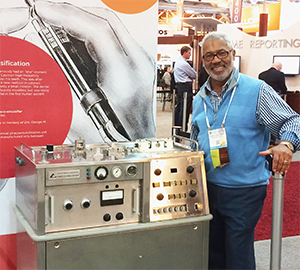Exploring Our Ophthalmic Heritage, Historical Controversies and Surgical Advances

Academy members such as Ronald L. Anderson, MD, of Washington, D.C., enjoyed being photographed with the museum’s Kelman Cavitron phaco machine at AAO 2017.
The Museum of the Eye's newest exhibit, “Cataract,” explores the history of cataract surgery in honor of phacoemulsification’s 50th anniversary. The exhibit focuses on the changes, challenges and controversies in surgical technique from ancient times to the present. At AAO 2017, the exhibit featured seven display cases containing cataract-related artifacts from all over the world — including Roman couching needles and one of the first phaco machines, the Kelman phacoemulsifier-aspirator model #7001, manufactured by Cavitron in the early 1970s and donated by the late Barrett G. Haik, MD.
The Museum of the Eye is the history and archives department of the Academy. The museum utilizes the 38,000-piece collection to celebrate the unique contributions of ophthalmology to science and health. The museum proudly serves as an educational resource for Academy members, medical historians, researchers and the public. In 2017 alone, more than 120,000 people visited the museum’s website.
To complement its latest exhibit, the Museum of the Eye presented a new history symposium during AAO 2017 titled, “Historical Controversies in Cataract Surgery: From Couching to Phaco.” This symposium traced the history of various cataract procedures and took a closer look at these great discoveries and even greater debates. Topics included:
- The 100 Years’ War: From Couching to Extraction
- ECCE vs. ICCE: Are the Parts Greater Than the Whole?
- Incisions and Sutures: To Close or Not to Close?
- Phacoemulsification: The Evolution of Surgical Technique
- IOLs: Location, Location, Location
- Phaco at 50: The Man and His Legacy
The Museum of the Eye also received two major book donations in 2017: an extremely rare volume of Georg Bartish’s Ophthalmodouleia: das ist Augendienst, published in 1583, and a second edition published in the 1600s. Donated by Christopher F. Blodi, MD, and Norman B. Medow, MD, respectively, this is the first ophthalmic text published in vernacular German. It is also the first extensively illustrated book for any surgical specialty, containing 91 full-page, woodblock prints. Together, the text and images are an astonishing record of the practice of ophthalmology during the Renaissance period.